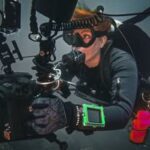Last Updated on January 22, 2025 by Candice Landau
Every time I get done with a weekend of “divemastering” I sit down to contemplate what I learned. Even if it’s a seemingly insignificant new tidbit of information, I find it useful to keep a record of it. This way I can cement whatever it is learned. Plus, the mere act of recalling the weekend of dives might prompt me to actually realize what I learned. After all, not all “lessons learned” are immediately obvious.
Sit down and think your own weekend through, or open up a journal and start writing about it. You may just surprise yourself!
Don’t believe me? Just read this article on “Growth Mindset.”
This weekend’s Open Water checkout class did not disappoint and I learned, or remembered a few useful things.
1. Ambient light significantly impacts visibility
This is especially noticeable in low-visibility scenarios. This weekend, doing a drift dive from the Florence Coast Guard tower to the North Jetty entrance, the instructors and divemasters doing the dive noticed the change in ambient light twenty minutes in. One said, “It was like going from day to night.”
Above the water we’d noticed the change too. The bright afternoon sunlight had been obscured by an all-encompassing marine layer. Peering into the water from the jetty rocks, what had seemed like five feet of visibility before, now looked more like a murky three.
Our final call for diving this site for Open Water checkouts? A definitive “No.” This was not a good day to put the students in the jetty in a situation that would be akin to night diving, and that would mean they would have to be glued to us as we dove so as not to get lost. All in all, not a fun idea for any of us.
While we are used to diving low visibility situations in Oregon, we don’t want to put people off diving, and don’t want to increase the risk of something going wrong — losing a student, a student panicking, etc. Thus, we called the jetty dive off and decided to do the third dive of the day the following day at our usual haunt in a nearby lake.
Up until this point I hadn’t realized quite how much ambient light affected visibility below water. And while our Divemasters disagreed a little on exactly what the visibility was, it was clear that the murky few feet they started with looked a lot less when the light went.

2. People process and learn information in different ways
This is not a new learning per se, but it is something I overhead my technical diving instructor say to a friend she was training to be a tech instructor too. “I try to explain something at least three times but in a different way each time. People process information differently, and you never know which explanation will be the one that hits home.”
Certainly, when she was explaining complex human physiology topics, the multiple explanations helped and I did notice that while I didn’t always understand all of the first explanation, with a couple of reframed explanations I could piece things together much better.
In this same way, for dive four of the Open Water training (the dive the students are supposed to plan and lead), I wished I had a map of the dive site, or a pen and a piece of paper. This way, instead of just explaining the dive site, I might have been able to draw it for the student thereby explaining the site in a different way.
Even better, if I’d had a white board, I might have had them illustrate their dive with a marker, making it much more of an interactive process.
3. Ask the students to explain concepts to you, then ask them to elaborate
With a visual of the dive site, I could also have easily prompted my students to think about various approaches. For example, if you find yourself in a dense section of fallen trees will you know whether or not you’re on course? And if not, how will you get back on track? What heading will you have to take? What sites do you expect to see along the way? What depth should you be at? Are there any other environmental markers you could use to set yourself straight again?
Prompting students to further explain something also pushes them to understand the reasoning behind the “rule.” For example, “What happens if you inflate your BCD as you ascend?” Student answers that they will rise and that the air in the BCD will expand. Instructor asks, “So what does that mean for your ascent speed? Will it be safe? How fast do you want to ascend? How will you know whether you’re ascending at the right speed?” And so on.
When you simply tell someone how to do something, they are not actively engaging. Open-ended questions that require a verbal “essay-like” response are much better for stimulating critical thinking.
4. Enforce good habits from dive 1
One of the good things about ensuring students are following best-practices right from the get go is that if you’re diving another site, as we sometimes do at Eugene Skin Divers Supply, they will already be in the habit of following these best practices. For example, sticking close to you. Or, communicating accurately.
And last, but not least…
5. Bungee chairs are good chairs for scuba divers!
Not only can you get them wet (they dry fast), but you can sit in them in any amount of gear (drysuit, wetsuit, etc). The only problem? Everybody else likes them too! You may lose your chair to a kid who likes bouncing in it…

















